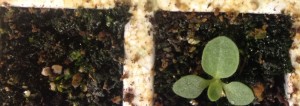Most greenhouses appear to have good seed germination and seedling uniformity. At the current time, seedlings between farms do vary in size depending on the type of production method being used and when seeding was started.
In some of the earlier seeded greenhouses a preventative application of fungicide has been made for the control of Rhizoctonia Damping-off. Clipping has started in some of the float tray greenhouses, while in some of the muckbed greenhouses, the seedlings have not yet filled in the seedbed.
Chilling Injury
Some concerns have been expressed regarding the amount of chilling injury being observed in some greenhouses. The initial symptoms are often a bright yellow colour in the growing point of the seedling and upward cupping of the leaves (as shown below).
Chilling injury
As the seedlings become larger and the leaves grow out, some leaves will be malformed, cupped and have a distinct yellow/white discolouration. Seedlings do outgrow chilling injury without any ill-effects on the seedlings when transplanted to the field.
Chilling injury is caused by exposure of the seedlings to a large variation in air temperature in the greenhouse. This can happen when ventilation occurs on a very cool but sunny day or at night when the temperature outside is quite cold and the temperature drops significantly in the greenhouse because the heaters do not have enough capacity to maintain the set temperature. Also, some varieties are more susceptible than others to chilling injury.
Effects of Algae on Emerging Seedlings in Trays
Certain algae present on the surface of tray media can affect seedling emergence and establishment. Two situations are usually seen in these cases, one where the seedlings are not able to emerge through the algae and the other being where the seedlings emerge, but cannot establish themselves before succumbing to the algae and dying (as shown below).
Seedling in left cell (light brown in colour) has succumbed to algae.
At this time of the year, growers typically see the after-effects of the algae, either empty cells or seedlings that only reached the 2-leaf stage and turned brown.
Cool and cloudy weather conditions are ideal for algae growth. Some algae, such as the green algae, possess motile appendages that allow them to move in the presence of water in tray media as seen in a video in the plant protection area of the website. This suggests that spread of algae in a tray can occur from cell to cell.
There are no chemical treatments for algae in tobacco greenhouses. Conditions that are optimum in the greenhouse for rapid seed germination and early seedling growth help seedlings to outpace the algae so that the seedlings become large enough that the algae can no longer affect them. Not fertilizing for 2 or 3 weeks after seeding can also help to prevent an early buildup of algae in trays. As seedlings grow, the canopy will close over and shade the media surface, therefore, reducing the negative effects of algae.
Further information about algae and measures to reduce its effect on seedlings can be found in a technical bulletin in the plant protection area of this website.
Post prepared and sent by Canadian Tobacco Research Foundation
Mailing Address: CTRF, P.O. Box 322, Tillsonburg, ON N4G 4H5
Telephone: 519-842-8997
Web Address: http://ctrf1.com



